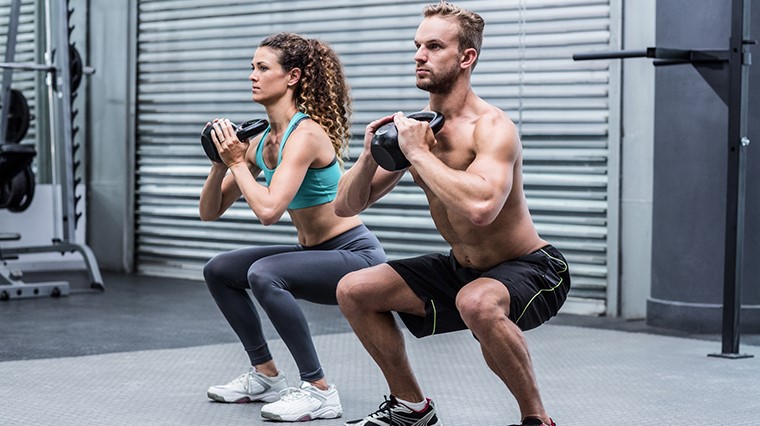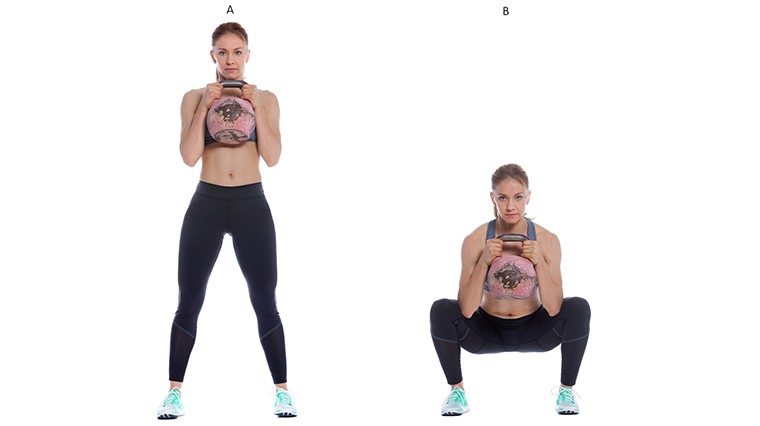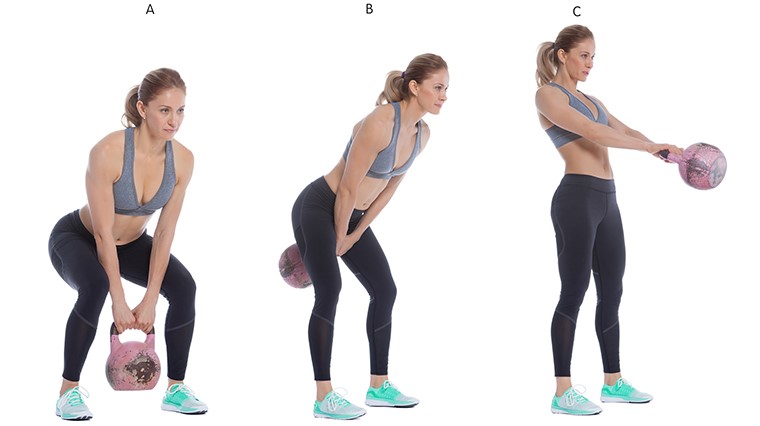A Beginner’s Guide To Toning Up With Kettlebells

Kettlebells have received well-earned hype for killer abs
that won’t cost you a weekly gym membership. Compact and versatile, they make it
easy to work up a sweat when you’re short on space and time.
But like any serious weight training, it’s important to know
how to use the tool correctly before integrating it into your workout.
Kettlebell versus
dumbbell
Dumbbells and kettlebells essentially serve the same function –
providing a weight to act as resistance for strength training.
Although for some exercises they can be used
interchangeably, typically dumbbells are used for basic, static exercises as
they are evenly weighted for controlled movements, targeting specific muscles.
Unlike the dumbbell, the cannonball-shaped kettlebell is not
equally balanced, lending it valuable for dynamic, explosive movements where
momentum is key, activating more muscle groups within a given exercise and with
aerobic benefits.
Choosing kettlebell weight

For beginners to weight training, usually 8kg is recommended for women and 12kg for men. Depending on the style of your training, you're likely to outgrow a lower weight quickly and it won’t be as effective for full-body exercises.
Kettlebell exercises activate multiple muscle groups simultaneously – meaning more of your muscles are in play to tolerate more weight – but seek the instruction
of a fitness professional for your specific needs. The aim is to challenge
yourself, not cause injury!
Kettlebell exercises
Aim for 10 - 12 reps in 3 sets.
Goblet squat

Benefits:
Full-body
workout that improves strength, stability and mobility. Goblet squats engage your core, build gripping
power and arm strength and target glutes, quads, hamstrings and calves. In
short, they tone your abs, shed fat and boost your booty.
How to:
A: Stand with
feet just further apart than shoulder-width and slightly pointed outwards. Grasp
the side of the kettlebell handles (the ‘horn') and hold at chest height with
elbows facing down, close to your body.
B: Brace your core and lower your
body to reach a squat stance by bending knees and hips, maintaining elbow
alignment so they land between your knees and with the weight focused at your
heels. Squat deeply with thighs at least parallel to ground to fully engage your glutes while
maintaining proper form. Hold for 2-3 seconds, using heels for balance.
Straighten to standing A stance, rising up with heels, legs
and butt in a smooth motion.
Watch out for:
Arching your spine, knees collapsing inwards, heels raising
off the floor or elbows pointing to the sides. If you cannot maintain proper form, you may have squatted
too deeply – stick to what is comfortable. Also keep eyes forward, not down.
A lighter kettlebell is preferable for this exercise – heavier
kettlebells will wear you out prematurely.
Deadlift

Benefits:
Hello calorie
burn! Deadlifts activate multiple muscle groups, particularly hamstrings and
glutes for a tush to die for, while tightening your core and strengthening
arm and back muscles.
Correct form in the kettlebell deadlift provides the
building blocks to perform the kettlebell swing and snatch safely and improves
posture. Plus, deadlifts make you feel super-duper strong - like the Hulk, but hotter.
How to:
A: Stand with
feet slightly more than shoulder-width apart, toes just pointed outwards and
kettlebell centred between them. Perform a hip-hinge, pushing your hips backwards to sit back into your glutes
with back neutral (not arched!) and bending your knees slightly, inhaling as
you lower your body down until both hands can comfortably grasp kettlebell
handle with an overhead grip (palms inward).
B: With arms
outstretched, core and glutes tightened and chin tucked in, exhale as you straighten
your body into a standing position, driving upwards with your heels, with
shoulders back and flexing your hips forward to align your body.
Watch out for:
This is not a
squat! Don’t be tempted lower your body deeply with thighs parallel to floor like
the goblet squat – hips should remain above your knees with arms extended. A
slow, controlled motion is the target, not speed.
Don’t lift with your arms – this exercise relies on your
lower body for lifting power. As your lower body rises to a standing position,
your arms, hands and kettlebell will naturally follow suit.
Russian kettlebell
swing

Benefits:
This one’s hella fun, but more advanced. It’s an awesome
full-body exercise for athletes like runner’s that let’s face it, have killer legs but can
lack hip strength.
It activates quads, hamstrings, calves and glutes, tightens
your abs for core strength and offers the best of both worlds with a blend of
cardio and strength training for a healthy, happy heart.
How to:
A: Stand with
feet slightly more than shoulder-width apart, toes just pointed outwards and
kettlebell centred between them. Perform a hip-hinge, pushing your hips backwards to sit back into your glutes
with back neutral and bend your knees
slightly, lowering your body down until both hands can
comfortably grasp kettlebell handle with an overhead grip – yep, just like the
setup for the deadlift. Your weight should be balanced equally between the
forefoot and heels.
B: It’s all in
the hips. Perform a sharp inhale simultaneously as you hike the kettlebell
between your legs and powerfully thrust your hips forward to create momentum,
driving the kettlebell. Exhale as the kettlebell rises forward in an
arc.
C: Allow your
arms to follow through, still extended as you reach a standing position with
chest up and glutes tight. Aim for the kettlebell to reach no higher than chest
height, but lower is okay.
At its peak, the kettlebell will feel weightless, and its
mass will dictate the motion back and forward.
Use your arms to guide the
kettlebell’s path, pushing your bum out and bending knees slightly for the next rep.
Watch out for:
Be careful to keep your back straight – don’t lean back as
the kettlebell reaches its peak. Keep your toes flat and heels solid on the
ground (image they’re rooted to the floor) to maintain stability throughout the
motion.
A word of caution
As super hot as your running shoes are, put them on the
sidelines when it comes to kettlebell training as their cushioning (designed to
withstand repetitive impacts on the road), can also hinder your stability in your home gym.
For beginners, don’t skip practicing the correct motion of
your exercises prior to introducing a weight into your workouts. Alongside
warming up, getting this right is key to an injury-free workout and exercising
in front of a mirror may help you identify problems in your technique.
We highly recommend seeking the aid of a personal trainer to guide your kettlebell exercises and train you in proper form for reduced injury risk.
